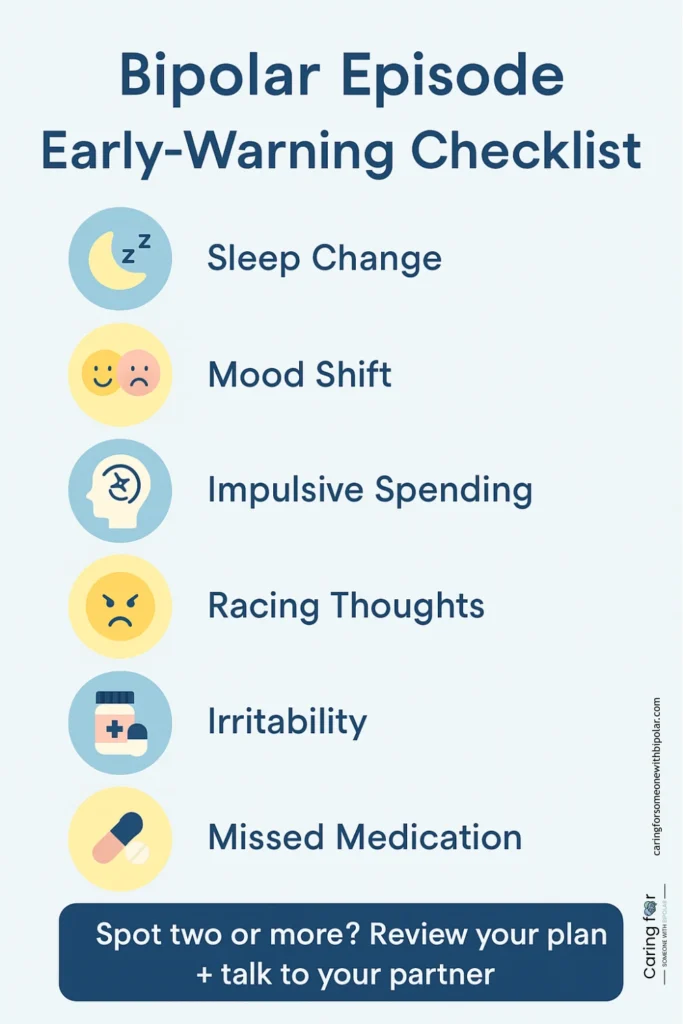Supporting a Spouse With Bipolar Disorder
Loving someone who lives with bipolar disorder can feel like riding a roller-coaster of manic highs and crushing lows. Both partners get tired fast. Yet, as the DSM-5 notes and the Mayo Clinic confirms, mood swings follow patterns you can learn to spot. With empathy, clear routines, and the right tools, a stable – sometimes even joyful – relationship is within reach.
The guide you’re reading breaks the job into seven therapist-backed moves. First, learn the basics of the illness. Then talk often and listen well. Agree on boundaries with a bipolar spouse so stress stays low. Build a shared bipolar crisis plan that lists early signs, PRN meds, and who to call. Help your partner take each dose on time. Guard your own health. Finally, lean on evidence-based care like Family-Focused Therapy (FFT), Interpersonal & Social Rhythm Therapy (IPSRT), or Cognitive-Behavioral Therapy (CBT).
Every step blends clinical research with lived wisdom from the NAMI Family-to-Family community. The goal: let you help a bipolar partner with confidence, not confusion, and protect the bond you both value.
Understanding Bipolar Disorder in Marriage
What Is Bipolar Disorder?
Bipolar disorder is a brain-based mood illness. It drives bursts of mania or hypomania and deep dips of depression. Each swing upends energy, sleep, judgement and money habits. In a marriage, these shifts shake conversation, intimacy, parenting and the family budget.
Two main forms (DSM-5)
- Bipolar I – at least one full manic episode, often followed by major depression.
- Bipolar II – lighter highs (hypomania) but longer, deeper lows.
Both types need lifelong care. Stick to prescribed meds, meet with a therapist, and keep a shared bipolar crisis plan handy. Clear boundaries with a bipolar spouse keep stress low for everyone.
How Bipolar Patterns Affect Relationships
Typical patterns may include:
- Emotional intensity: affection can quickly turn to irritability or withdrawal.
- Unpredictable behavior: one partner may feel they’re constantly “walking on eggshells.”
- Cycles of calm and crisis: Life with bipolar disorder moves in loops. Weeks of steady, “normal” life can flip into a sudden mood swing that shakes trust and upends daily routines.
Spotting this pattern early lets both partners act – not over-react. Without that insight, it’s easy for the well partner to shoulder blame or answer in ways that feed the chaos.
Evidence Snapshot – Journal of Affective Disorders (2023)
- Skipping doses drives the five-year relapse rate up to 25 %.
- Leaving bipolar untreated pushes the risk of divorce to roughly 40 %.
- Family-Focused Therapy (FFT) can cut relapses by 60 % versus standard care.
Source: “The Impact of Bipolar Disorder on Couple Functioning: Implications for Care and Treatment — A Systematic Review,” J. Affective Disorders, 2023.
Recognizing Undiagnosed Bipolar Symptoms
Your partner might have bipolar disorder, even if not diagnosed. Look for signs like high energy followed by deep lows, late-night projects, quick spending, little sleep, sudden withdrawal, or angry outbursts. Talking about it is tricky, but it’s the first step to understanding.

Spotting Red Flags Early
Only a qualified clinician can diagnose bipolar disorder. However, some repeating patterns should lead to a closer look:
- Repeated cycles of extreme energy followed by exhaustion or depression
- Impulsive spending, grandiosity, or risky behavior
- Irritability or rage that seems out of proportion
- Prolonged emotional numbness, sadness, or apathy
- Unrealistic plans or inflated self-esteem during high-energy phases
These signs don’t confirm bipolar disorder, but they may warrant an evaluation.
Starting the Conversation With Care
Rather than labeling or confronting, focus on how their behaviors affect both of you. Use “I” statements and express concern, not criticism.
For example:
- Use “I” statements: “I’ve noticed you haven’t been sleeping. I’m worried.” Focus on impact, not labels.
- “Lately, our moods have felt very unpredictable. I wonder if it might help to talk to someone who could help us both understand what’s going on.”
Avoid diagnosing or arguing. The goal is not to push them but to plant a seed of insight and open a path toward professional help.
When Your Partner Resists Help
People often deny needing help, especially during manic or hypomanic phases. If your spouse resists:
- Offer to attend a session together
- Share a non-judgmental resource, such as a quiz or video on mood disorders
- Wait for a calm moment to revisit the conversation
Patience is essential. People often open up more during a depressive phase or after a big event from manic behavior.
Day-to-Day Life With a Bipolar Partner
Boundaries With a Bipolar Spouse
Life with a bipolar spouse is a hike on shifting ground. Long calm stretches do happen, but day-to-day hurdles still pop up. Clear talk, shared routines, and firm limits make those hurdles smaller. Bipolar symptoms can disrupt daily tasks like sleep, chores, and bills. By noticing these changes, you can prevent fights and protect both partners’ well-being.
Communication Do’s and Don’ts
Do:
- Keep communication calm and non-reactive, especially during heightened moods.
- Use specific observations rather than generalizations.
Example: “I noticed you’ve been sleeping less this week” instead of “You’re acting manic again.” - Validate emotions while setting boundaries.
“I can see you’re upset. I want to talk when we’re both calm.”
Don’t:
- Engage in arguments during a manic or depressive episode.
- Dismiss their experiences or symptoms.
- Take emotional swings personally.
Consistent, respectful communication can reduce the chance of escalation and help your spouse feel less isolated during difficult periods.
Managing Shared Responsibilities
Case Example – “Alex & Jordan”
🕯️Alex (cyclical hypomania) and Jordan set up a shared Google Sheet:
- Fixed tasks: rent, school, groceries.
- Adaptive tasks: Jordan manages finances if Alex’s sleep score ≤ 4/10.
- Result: Logistical disputes went down by three in 90 days. The risk of financial instability in a bipolar marriage also dropped significantly.
A bipolar partner’s capacity to manage chores, finances, or parenting may fluctuate. Some strategies include:
- Shared schedules: Use apps or planners to organize routines and medication reminders.
- Household flexibility: Adjust tasks based on their current energy and functioning.
- Contingency planning: Prepare for mood swings with financial contingency plans. Without forgetting childcare or key responsibilities.
Handling Risky Financial Behavior
Manic episodes can cause impulsive choices. These might include overspending, making risky investments, or suddenly quitting jobs. To protect both of you:
- Consider separate bank accounts with agreed spending limits.
- Use financial tracking tools or a third-party advisor.
- Discuss setting up spending agreements in calm phases to avoid future conflict.
Creating these routines helps during tough times. It also builds trust by planning ahead.
Creating a Bipolar Crisis Plan Together
Even with treatment and support, severe mood episodes may still occur. A clear crisis plan cuts down on confusion and panic. It makes sure both partners know what to do if things get worse. Preparing during a period of stability is key.

Key Elements of a Bipolar Crisis Plan
- Early-warning signs —Look for clues of mania or depression. Symptoms can include sleepless nights, impulsive spending, or dark thoughts.
- Medication agreements — Identify who tracks refills. Set reminders. State what to do if a dose is skipped or refused.
- Emergency contacts — Add phone numbers for doctors, therapist, trusted friends, and family who can step in fast.
- When to call for help — Draw a clear line: rough day vs. emergency. Show when to call a crisis line, urgent-care clinic, or 911.
- Episode responsibilities — Decide ahead who handles bills, childcare, meals, and pets if your partner can’t.
- Legal & Safety Papers — Keep power-of-attorney forms, advance directives, and consent-to-treat letters all in one handy folder.
Define roles before symptoms flare so the plan feels protective – not punitive.
Defining Emergency Protocols
Talk about this plan during a time of emotional calm, using a collaborative tone. This plan protects both partners and the relationship, not just one person’s health.
Example: “I know things are good now, but if they shift again, I want us to be ready. Can we write down what you’d want me to do if you’re struggling?”
Legal & Safety Preparations
Put your crisis plan in writing, print a copy, and save it in a shared location. You might also consider:
- A shared mood tracking app (e.g., Bearable, eMoods)
- A PDF template or checklist for emergency response
This lowers fear and helps both partners act clearly when things get unstable.
Financial Instability Bipolar Marriage: Protecting Your Financial Well-Being
While love and empathy are crucial, they must be balanced with clear safeguards. Bipolar disorder can fog judgment and trigger sudden actions. Those actions may cause financial instability bipolar marriage or even legal trouble. Planning ahead shields you, your partner, and the whole family.
Separate vs. Joint Finances
Many couples choose to manage money together. If your spouse has manic episodes that include overspending, risky investments, or piling up debt, think about:
- Setting up separate accounts with agreed-upon spending limits
- Creating a monthly budget together with a buffer for unpredictability
- Using apps or tools for transaction tracking and alerts
Talk about these changes when things are calm. Present them as safeguards, not as punishments.
Power of Attorney and Advance Directives
A severe manic or depressive episode can block clear thinking. Signed papers keep life steady when that happens.
Power of Attorney (POA)
Gives you – or another trusted person – the right to pay bills, sign forms, and speak with doctors if your spouse can’t.
Mental-Health Advance Directive
- List hospitals your partner prefers or dislikes.
- Note any specific medicines they want or don’t want.
- Write down treatments they agree or disagree with.
Store these legal tools with your bipolar crisis plan. Share copies with doctors and important family members. They protect children, shared assets, and urgent care decisions.
These tools are especially important if children, shared assets, or medical care are involved.
Addressing Emotional or Financial Abuse
Not all relationships remain healthy during chronic illness. If your partner:
- Uses their diagnosis to manipulate or control you
- Endangers the family’s finances during manic episodes
- Refuses all forms of treatment and causes repeated harm
Consider talking to a lawyer, therapist, or domestic abuse advocate. This is important, even if there’s no physical violence.
Being supportive does not mean sacrificing your own safety, autonomy, or peace of mind.
Parenting With a Bipolar Spouse
Raising children when one partner has bipolar disorder can feel rich and rough. Kids watch the mood swings but may not grasp why Mom or Dad changes overnight. Steady the home with three basics: clear talk, firm routines, and outside help when needed.
Bipolar parenting tips in action
- Explain in plain words. “Dad’s brain has speedy days and slow days; it isn’t your fault.”
- Lock in routines. Meals, homework, and bedtime stay on the same clock, even during an episode.
- Practice the plan. Walk through the family bipolar crisis plan at bedtime the way you would a fire drill.
- Post numbers. Pin the crisis phone list on the fridge so older kids know whom to call.
- Ask for backup. A grandparent sleep-over or sitter shift can give both parents breathing room.
These small steps give children the safety net they crave and lower stress for everyone in the house.
Explaining Bipolar to Children
It’s important to explain bipolar disorder in age-appropriate language. For younger kids:
- Use simple terms like “sometimes mom/dad’s brain gets really tired or really fast”
- Reassure them that the parent’s mood is not their fault
- Emphasize safety, love, and predictability
For teens:
- Offer more detail about symptoms and treatment
- Encourage open conversation while respecting your spouse’s privacy
- Consider involving a therapist for family support
Avoid hiding the condition. Silence can increase confusion and anxiety for children.
Building Stability Through Structure
Children thrive on predictability, especially when one parent’s behavior may change unpredictably. Tools to help:
- Daily routines for meals, bedtime, and homework
- A clear schedule with consistent caregivers
- Backup plans in case your spouse becomes unavailable during an episode
Share parenting duties realistically, based on your partner’s current stability. Healthy house rules double as boundaries with a bipolar spouse – for example, “No major decisions after 9 p.m.” saves everyone from late‑night chaos.
Managing Co-Parenting Stress
During manic phases, impulsive spending can trigger financial instability bipolar marriage. Involve older children in a “needs vs. wants” game to model smart choices. It’s common to feel like you’re “parenting alone” during certain phases of your spouse’s illness. Seek support if:
- You feel emotionally or physically burned out
- Your partner undermines routines or becomes emotionally volatile
- The household environment feels unsafe or inconsistent
Children need at least one calm, present parent. If that parent is you for now, that is okay. Show them that treatment is not a flaw but an act of courage. Meet once a week for a short “parent check-in.”Review your school notes. Ensure your bipolar crisis plan includes childcare in case you need a hospital stay.
Evidence-Based Therapies & Digital Tools
When bipolar disorder is part of a marriage, therapy isn’t just for symptoms. It repairs trust, sharpens communication, and trains both partners to work as one team. The good news is that couples with mood swings have several proven methods to try. Family-Focused Therapy (FFT), Interpersonal & Social Rhythm Therapy (IPSRT), and Cognitive-Behavioral Therapy (CBT) are top options.
| Criteria | Family-Focused Therapy (FFT) | Interpersonal & Social Rhythm Therapy (IPSRT) | Cognitive-Behavioral Therapy (CBT) |
|---|---|---|---|
| Core goal | Reduce relapse by improving family communication and problem-solving. | Stabilise daily rhythms (sleep, meals, activity) to prevent mood swings. | Re-frame thought patterns that drive mood & behaviour. |
| Typical format | 21 sessions over 9 months; spouse / children attend. | 16–20 weekly sessions; individual. | 12–20 sessions; individual or couples. |
| Evidence | 60 % ↓ relapse vs TAU (Miklowitz 2016). | 42 % ↑ time to relapse vs TAU (Frank 2014). | ≈ 30 % ↓ depressive symptoms vs wait-list (Weinstock 2022). |
| Strengths | Teaches concrete communication scripts; includes caregivers. | Great for sleep-sensitive patients; low drop-out. | Highly scalable; many self-help apps available. |
| Limitations | Needs family buy-in & trained clinician. | Requires strict routine tracking; not ideal for shift-workers. | Less effective for acute mania; homework compliance critical. |
| Insurance | Usually covered as “family psychotherapy”. | Covered as individual therapy + psycho-education. | Widely covered; group CBT is lowest cost. |
Family-Focused Therapy (FFT)
Originally developed for families and couples dealing with bipolar disorder, FFT:
- Helps identify early warning signs of episodes
- Teaches problem-solving skills
- Improves communication between partners
- Encourages collaborative treatment planning
Family-Focused Therapy (FFT) lowers the risk of relapse. It also tightens the bond between partner and caregiver. That makes FFT a strong choice for couples in the long run.
Interpersonal and Social Rhythm Therapy (IPSRT)
This therapy focuses on:
- Establishing daily routines around sleep, meals, and activity
- Improving interpersonal relationships
- Reducing stress that can trigger mood episodes
IPSRT helps stabilize mood. It’s often suggested with medication and therapy.
Couples Counseling & Helpful AppsWorking with a therapist who understands mood disorders can help partners:
- Explore how bipolar has affected the relationship
- Set healthy boundaries
- Rebuild intimacy and emotional connection
- Clarify what each partner needs to feel supported and respected
Look for therapists who specialize in chronic illness, bipolar disorder, or trauma-informed care.
Many couples use mood tracking and shared scheduling apps to stay aligned:
Shared medication trackers for accountability
- eMoods or Bearable for mood tracking
- Cozi or Google Calendar for routines and reminders
By combining therapy with tools, couples find structure and space to reconnect, even during tough times.
Prioritizing Your Own Self-Care
Loving and supporting a partner with bipolar disorder can be emotionally exhausting. You and your spouse can use the same bipolar crisis plan. Still, you both need quiet time away from symptoms and pills. Your partner’s needs may feel urgent every day. Skip your own rest and limits, though, and burnout, resentment, or even a breakdown can follow. Long‑term care for someone else starts with consistent care for yourself.
Setting Healthy Boundaries
Boundaries are not punishments. They are safety lines that keep you steady and able to care. Setting firm limits with a bipolar spouse is not selfish – it is a lifeline for both of you. Watch for signs of financial trouble in a bipolar marriage. Look out for impulse buys or hidden credit cards? Stop, breathe, and call your accountability buddy before emotions flare.
Examples of healthy boundaries:
- “I won’t engage in arguments during manic episodes.”
- “If you stop taking your medication, I’ll step back from managing finances.”
- “I need at least one evening per week for myself.”
Communicate boundaries clearly, calmly, and consistently. Follow through if they are crossed.
Recognizing Caregiver Burnout
You may be burned out if you notice:
- Chronic exhaustion or sleep problems
- Irritability or emotional numbness
- Isolation from friends or loss of personal interests
- Trouble concentrating or making decisions
These are signals to slow down and seek help. Simple rituals like journaling or walking the dog can recharge you so you can truly help a bipolar partner during unpredictable mood swings.
Building a Support System
No one should go through this alone. Consider:
- Joining a support group for spouses of people with mental illness
- Speaking regularly with a therapist who understands caregiver stress
- Sharing updates with a close friend or family member is helpful. They can provide non-judgmental support.
You don’t have to get everything right. You deserve clear limits and breathing room. Care for yourself while staying kind. Every three months, check your safety net:
- Confirm your therapist’s phone number.
- Arrange backup childcare.
- Put a printed copy of the bipolar crisis plan in the glove box.
Frequently Asked Questions
Conclusion: Supporting With Strength and Compassion
Supporting a Spouse With Bipolar Disorder is hard work. It demands emotional grit, firm limits, and steady empathy. With good facts, clear structure, and a shared promise, many couples stay strong. They remain stable, even when moods change.
You don’t have to do this alone. Help is available, whether you’re dealing with a diagnosis, daily challenges, or a crisis. And just as your partner deserves support, so do you.
How to Help a Bipolar Partner Right Now (CTA)
- Download in next our Crisis Plan Template to prepare for mood episodes.
- Explore related guides on How to Help During a Manic Episode or Parenting With a Bipolar Spouse.
- Share this article with friends or therapists who can join your support circle.
Healthy relationships begin with honest talks. It takes courage to ask for help, set limits, and keep supporting each other.
References
- Bipolar disorder – symptoms & causes | Mayo Clinic
- Family-Focused Therapy for adolescents with bipolar disorder – PubMed abstract
- NAMI “Family-to-Family” free 8-session program
- 988 Suicide & Crisis Lifeline – SAMHSA
- Systematic review: medication adherence & relapse in bipolar disorder (Psychological Medicine, 2021)
- Bipolar disorder – diagnosis & treatment | Mayo Clinic
- Legal advice on spouse debt during divorce (MarketWatch column)





